Situational awareness is the cornerstone of effective decision-making in both personal and professional settings. This critical skill enables individuals to perceive, comprehend, and anticipate events in their environment, ensuring they can respond effectively to challenges and opportunities. Whether you’re navigating a bustling city street, managing a high-stakes business meeting, or leading a team in a crisis, situational awareness can be the key to success. But what exactly does it entail, and why is it so essential?
The Definition of Situational Awareness
Situational awareness refers to the ability to understand what is happening around you, interpret the significance of those events, and predict how they might unfold. This concept, rooted in fields like aviation, military strategy, and emergency response, has since found relevance in everyday life and various industries. At its core, this awareness is about staying alert, gathering information, and processing it to make informed decisions.
The Three Levels of Situational Awareness
To fully grasp the importance of this awareness, it’s helpful to break it down into three distinct levels:
- Perception: This is the first step and involves observing the elements in your environment. It might include noticing traffic patterns, observing body language in a conversation, or identifying changes in market trends.
- Comprehension: After gathering data, the next step is to interpret it. This level involves understanding the relationships between observed elements and discerning their significance. For instance, recognizing that a sudden drop in temperature and dark clouds mean an impending storm.
- Projection: The final level is predicting how the situation will evolve. Based on your understanding, you can anticipate potential outcomes and prepare for them effectively.
Why Is Situational Awareness Important?
- Safety: Situational awareness plays a crucial role in ensuring safety in potentially hazardous situations. For example, drivers with high situational awareness can anticipate and avoid accidents by staying vigilant and reading the behavior of other drivers.
- Effective Decision-Making: Being aware of your surroundings allows you to make better decisions. Whether in a business setting or a personal scenario, understanding the dynamics at play helps you choose the best course of action.
- Enhanced Productivity: In the workplace, this awareness contributes to improved productivity by allowing employees to identify and address challenges proactively.
- Improved Relationships: This awareness extends to social contexts as well. Being attuned to others’ emotions and body language fosters empathy and stronger interpersonal connections.
Applications of Situational Awareness in Daily Life
Situational awareness is not confined to professionals in high-stakes fields. It has practical applications in everyday scenarios:
- Driving: Staying alert to road conditions, weather, and other drivers’ actions is a prime example of situational awareness.
- Parenting: Parents often need to be aware of their children’s activities and surroundings to ensure their safety and well-being.
- Workplace: Employees with strong situational awareness can identify risks, adapt to changes, and contribute to a harmonious work environment.
- Travel: Travelers benefit from this awareness by avoiding potential dangers and making the most of their experiences.
How to Develop Situational Awareness
- Practice Mindfulness: Being present in the moment and fully engaged with your surroundings is the foundation of this awareness. Mindfulness exercises, such as meditation, can enhance your ability to focus.
- Hone Observation Skills: Train yourself to notice details. This might involve paying attention to people’s facial expressions, reading signage, or observing environmental changes.
- Ask Questions: Cultivate curiosity about your environment. Questions like “What’s happening here?” and “Why is this occurring?” can sharpen your understanding.
- Stay Informed: Knowledge is power. Staying updated on local news, weather forecasts, and industry trends equips you to anticipate developments.
- Simulate Scenarios: Imagining “what if” situations can prepare you for unexpected events. For instance, consider how you’d react in an emergency or adapt to a sudden change in plans.
- Seek Feedback: In professional settings, feedback from colleagues or mentors can provide insights into areas where your awareness might need improvement.
Common Barriers to Situational Awareness
Despite its importance, several factors can impede situational awareness:
- Distractions: In today’s digital age, constant notifications and multitasking often detract from being present in the moment.
- Stress: High stress levels can cloud judgment and hinder your ability to process information effectively.
- Overconfidence: Assuming you’re always aware can lead to complacency and blind spots.
- Fatigue: Physical and mental exhaustion can diminish your alertness and reaction time.
The Role of Situational Awareness in Leadership
Leaders, in particular, benefit greatly from this awareness. A leader with keen situational awareness can:
- Identify Opportunities and Threats: Recognizing shifts in the market or changes in team dynamics allows leaders to act proactively.
- Enhance Team Cohesion: Being attuned to team members’ needs and concerns fosters trust and collaboration.
- Navigate Crises Effectively: During times of uncertainty, this awareness helps leaders maintain composure and guide their teams to solutions.
Read Also : How Does Spatial Awareness Shape Our Daily Lives?
Situational Awareness in Technology
Advancements in technology have transformed how we approach this kind of awareness. From GPS navigation systems to real-time data analytics, tools now enhance our ability to monitor and interpret our environment. However, reliance on technology also underscores the need for individuals to retain their observational and analytical skills to avoid overdependence.
Examples of Situational Awareness in Action
- Aviation: Pilots rely heavily on this awareness to monitor weather conditions, aircraft systems, and air traffic. A lapse in awareness can lead to catastrophic outcomes.
- Healthcare: Surgeons and emergency room staff must remain highly aware of patient vitals and team communication to ensure successful outcomes.
- Sports: Athletes demonstrate this awareness by reading their opponents’ moves and anticipating game developments.
- Security: Law enforcement and security personnel use this awareness to assess risks and maintain public safety.
Conclusion: The Lifelong Importance of Situational Awareness
Situational awareness is not a skill we are born with but one that we develop over time through practice and experience. By cultivating this essential skill, we enhance our ability to navigate life’s complexities with confidence and foresight. Whether it’s about ensuring safety, excelling in your career, or building meaningful relationships, the awareness remains a vital asset.
In a world where distractions are plentiful and challenges unpredictable, honing your situational awareness could be the difference between merely surviving and truly thriving. So, take the time to observe, interpret, and anticipate—your future self will thank you.

